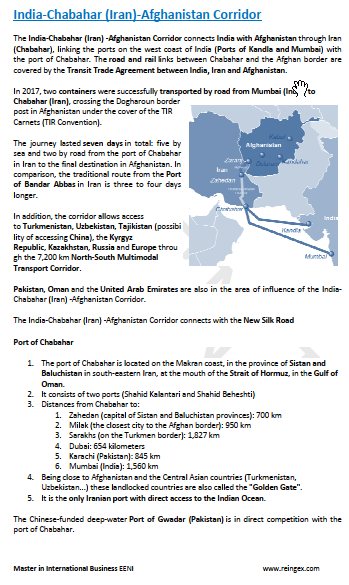India Iran (Chabahar) Afghanistan Corridor
India-Chabahar (Iran)-Afghanistan Transport Corridor, Mumbai, Transit Agreement
- Introduction to the India-Chabahar (Iran)-Afghanistan Corridor
- Main characteristics of the India-Chabahar (Iran)-Afghanistan Corridor
- Chabahar-Zahedan-Bam-Hajigaj Railway
- Mashhad-Herat-Mazar-El-Sharif Railway
- Transit Trade Agreement between India, Iran and Afghanistan
- Countries in the corridor's area of influence: Turkmenistan, Uzbekistan, Tajikistan, Kyrgyzstan, Kazakhstan, Pakistan, Russia, the United Arab Emirates and Oman
- The corridor and the Silk Road
- The North-South Corridor (India-Russia)
Sample - African India-Chabahar (Iran)-Afghanistan Transport Corridor


The Subject “India-Chabahar (Iran)-Afghanistan Corridor” is included within the curriculum of the following academic programs at EENI Global Business School:
Logistics Courses: Road transport, Multimodal Transport, Rail transport.

Certificate in International Transport

Masters: International Transport, International Business.


Languages:  .
Summary in
.
Summary in  Corridor Inde-Chabahar (Iran)-Afghanistan
Corridor Inde-Chabahar (Iran)-Afghanistan  Corredor India-Chabahar (Irán)-Afganistán
Corredor India-Chabahar (Irán)-Afganistán  Corredor Índia-Chabahar (Irão)-Afeganistão.
Corredor Índia-Chabahar (Irão)-Afeganistão.

India-Chabahar (Iran)-Afghanistan Corridor.
The India-Chabahar (Iran) -Afghanistan Corridor connects India with Afghanistan through Iran (Chabahar), linking the ports on the west coast of India (Ports of Kandla and Mumbai) with the port of Chabahar. The road and rail links between Chabahar and the Afghan border are covered by the Transit Trade Agreement between India, Iran and Afghanistan.

In 2017, two Containers were successfully transported by road from Mumbai (India) to Chabahar (Iran), crossing the Dogharoun border post in Afghanistan under the cover of TIR Carnets (TIR Convention).
The journey lasted seven days in total: five by sea and two by road from the port of Chabahar in Iran to the final destination in Afghanistan. In comparison, the traditional route from the Port of Bandar Abbas in Iran is three to four days longer.
In addition, the corridor allows access to Turkmenistan, Uzbekistan, Tajikistan (possibility of accessing China), the Kyrgyz Republic, Kazakhstan, Russia and Europe through the 7,200 km North-South Multimodal Transport Corridor.
Pakistan, Oman and the Emirates are also in the area of influence of the India-Chabahar (Iran) -Afghanistan Corridor.
The India-Chabahar (Iran) -Afghanistan Corridor connects with the New Silk Road
Port of Chabahar
- The port of Chabahar is located on the Makran coast, in the province of Sistan and Baluchistan in south-eastern Iran, at the mouth of the Strait of Hormuz, in the Gulf of Oman
- It consists of two ports (Shahid Kalantari and Shahid Beheshti)
- Distances from Chabahar to:
- Zahedan (capital of Sistan and Baluchistan provinces): 700 km
- Milak (the closest city to the Afghan border): 950 km
- Sarakhs (on the Turkmen border): 1,827 km
- Dubai: 654 kilometers
- Karachi (Pakistan): 845 km
- Mumbai (India): 1,560 km
- Being close to Afghanistan and the Central Asian countries (Turkmenistan, Uzbekistan...) these landlocked countries are also called the "Golden Gate"
- It is the only Iranian port with direct access to the Indian Ocean
The Chinese-funded deep-water Port of Gwadar (Pakistan) is in direct competition with the port of Chabahar.
Chabahar-Zahedan-Bam-Hajigak Railway
- India is finalising a plan to build the Chabahar-Zahedan-Hajigak railway line (900 km) that will connect the Port of Chabahar with the Hajigak region of Afghanistan (very rich in minerals, the largest Asian iron ore deposit)
- The Chabahar-Zahedan railway section is also being developed, as part of the North-South Transport Corridor
Mashhad-Herat-Mazar-El-Sharif Railway
- This railway route connects Mashhad (northeast of Iran) with Herat (northwest of Afghanistan), passing through Khaf, Sangan, Shamtiq (Iran-Afghanistan border)
- In Herat there are links to Turkmenistan via rail and road routes
- In Mazar-El-Sharif there are links to Uzbekistan and Tajikistan via the railway, as well as via road routes to other Central Asian countries
Transit Trade Agreement between India, Iran and Afghanistan.
The trilateral transit agreement signed by India, Iran and Afghanistan allows Indian products to arrive in Afghanistan through Iran.
On October 29, 2017, the trilateral transit route was implemented when the first shipment of wheat was shipped from India to Afghanistan via Chabahar.
India will also develop several industries, including aluminum and urea production plants, in the Chabahar economic zone located in the port.
Asian regional economic communities related to the India-Chabahar (Iran)-Afghanistan Corridor
- Central Asia Cooperation (CAREC): Afghanistan, Azerbaijan, China, Kazakhstan, Kyrgyzstan, Mongolia, Pakistan, Tajikistan, Turkmenistan, and Uzbekistan. Iran is an observer country
- Economic Cooperation Organization (ECO): Afghanistan, Azerbaijan, Iran, Kazakhstan, Kyrgyzstan, Pakistan, Tajikistan, Turkey, Turkmenistan, and Uzbekistan
- Organization for Cooperation between Railways (OSJD): Azerbaijan, Albania, Afghanistan, Belarus, Bulgaria, Hungary, Vietnam, Georgia, Iran, Kazakhstan, China, North Korea, South Korea, Cuba, Kyrgyzstan, Latvia, Lithuania, Moldova, Mongolia, Poland, Russia, Romania, Slovakia, Tajikistan, Turkmenistan, Uzbekistan, Ukraine, the Czech Republic and Estonia
- South Asian Association for Regional Cooperation: Afghanistan, Bangladesh, Bhutan, India, Maldives, Nepal, Pakistan and Sri Lanka
- Asian Clearing Union: Bangladesh, Bhutan, India, Iran, Myanmar, Maldives, Nepal, Pakistan and Sri Lanka
- Iran e India are members of the Indian-Ocean Rim Association
- India is a member of:
Related Trade Agreements
- India
- Trade Agreements with Sri Lanka, Thailand, Indonesia, Singapore, ASEAN, South Korea, the EU, New Zealand, Africa-India, Mauritius, Canada, Australia, GCC, SACU, EFTA, MERCOSUR, Andean Community..
- Iran
- Trade Agreements with Algeria, Armenia, Syria, Venezuela, Pakistan
Main Asian institutions related to the Bangladesh-China-India-Myanmar Economic Corridor
- Asian Development Bank
- Economic Commission for Asia (ESCAP)
- Boao Forum for Asia
- Colombo Plan
- Asia Cooperation Dialogue
Main Islamic institutions related to the Bangladesh-China-India-Myanmar Economic Corridor
- Organization of Islamic Cooperation (OIC)
- Islamic Development Bank
The main Religions of the region of the Bangladesh-China-India-Myanmar Economic Corridor are:
The India-Chabahar (Iran)-Afghanistan Corridor belongs to the:
(c) EENI Global Business School (1995-2025)
Top of this page









 WhatsApp
WhatsApp